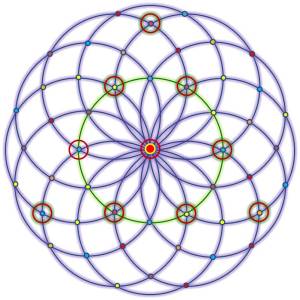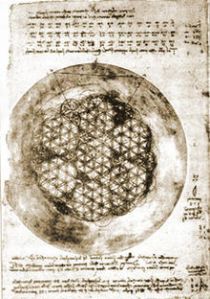Tetraktys in Seed of Life – Tim McKamey
The image at left is something I came up with around 2003 using two figures from sacred geometry: (click image to enlarge)
1) The Tetraktys of Pythagoras (6th century BC) is the arrangement of ten nodes in the familiar pattern of the ten pins in bowling. (see below)
2) The Seed of Life is a component of the more complex figure, The Flower of Life which can be found in many cultures going at least as far back as Assyria and ancient Egypt. My design actually incorporates the geometric figure of the tube torus. The true Seed of Life only has six circles arranged around a central circle representing a six-fold symmetry, whereas the tube torus figure doubles those six circles into twelve-fold symmetry. (see below)
The Tetraktys
“The Tetraktys pictured at right [also known as the decad] is an equilateral triangle formed from the sequence of the first ten numbers aligned in four rows. It is both a mathematical idea and a metaphysical symbol that embraces within itself — in seedlike form — the principles of the natural world, the harmony of the cosmos, the ascent to the divine, and the mysteries of the divine realm. So revered was this ancient symbol that it inspired ancient philosophers to swear by the name of the one who brought this gift to humanity — Pythagoras.”
The quote above about the tetraktys of Pythagoras is attributed to Iamblichus, (c. 245-c. 325) an Assyrian, Neoplatonist philosopher who determined the direction taken by later Neoplatonic philosophy. He is perhaps best known for his compendium on Pythagorean philosophy. I came across the quote, along with the animated .GIF pictured at right, at http://www.organelle.org/organelle/tetra/tetraktys.html just last night – several years after coming up with my Tetraktys in Seed of Life design pictured at top of this page. (My design is not animated, only the representation of the tetraktys above right is animated.) I encourage you to visit the organelle website and explore the author’s ideas further. The math is very basic, the philosophic implications are profound. I especially appreciate his sense of the tetraktys as a ‘toy’ which Pythagoras brought back with him from his “journey across the veil”. The author and designer (d. de Stephano) goes on to explain,
“…the tetraktys offers a foothold in a universe that exists between, around, beneath, above, before, behind with(in) and after the dimensions we are familiar with. This ‘place of between and before’ is actually a unified being, comprised of forms of intelligent life we have no reasonable names for — yet. Some have called them angels, but to mathematicians they are angles — obviously we are at least moderately confused about them.“
de Stefano’s blend of insight, intelligence and sense of play is refreshing. I struggled with math as a young student because it seemed so abstract and meaningless. Presented as de Stefano does it comes alive and is brought to bear on some of the most important issues of our time. We are encouraged to look deeper when he tells us,
“There are ways of learning near at hand…”
Before moving on to the Seed of Life explanation below, consider how de Stefano clarifies the importance of Pythagoras’s tetraktys ‘toy’ and how it unifies dimensions of knowledge we normally consider separate:
“Being a toy of generalization, the tetraktys is a visual hypostasis of a holophore — a playful model of ‘everything at once’, which has the power of unifying dimensions of knowledge we normally consider separate: numerism, music, geometry, dialectic, and the study of bodies in motion. Effectively, Pythagoras discovered the unified field theorem’s sources — and was determined to see that they were not lost once we had access. As a teaching-model, the power of this toy lies not in what it brings, but what it takes away — it removes divisions between multiple simultaneous domains of knowledge and learning, by providing an exceptionally general stage upon which various shape-based parables of the various perspectives on relativity may be extemporaneously demonstrated.”
The Seed of Life
Examples of the Seed of Life and other component/variations of the Flower of Life, including the Egg of Life, Fruit of Life, Tree of Life, etc… can be found around the world carved in stone or incorporated in some way in the architecture of temples and palaces, tombs and manuscripts as far back as 645 BC. It has been sighted in Assyria, Egypt, Romania, Israel, China, Japan, India, Bulgaria, Turkey, Spain, Austria, Italy, Morocco, Lebanon and various Islamic Mosques, Peru and Mexico.
As mentioned above, my design of Tetraktys in Seed of Life technically uses a Tube Torus figure rather than a true Seed of Life figure. Below we have the true Seed of Life at left with the Flower of Life at right. In the middle you can see that the Tube Torus is simply a Seed of Life where the six circles have been racheted around to twelve circles giving the impression of a circular tube ‘bent’ in the fashion of a torus.
Seed of Life Tube Torus Flower of Life
Thirteen circles taken from the design of the Flower of Life symbolize the Fruit of Life, said to be the blueprint of the universe, containing the basis for the design of every atom, molecular structure, life form, and everything else in existence.
It contains the geometric basis for Metatron’s Cube (below) which brings forth the platonic solids. If each circle’s center is considered a node, and each node is connected to each other node with a single line, a total of seventy-eight lines are created, forming Metatron’s Cube.

Below left, a page from Leonardo da Vinci’s Notebooks with variations of the Flower of Life design. At right is the Tree of Life from the ancient mystical Hebrew Kabalah derived from the Flower of Life design.
The formation of the Seed of Life in the steps pictured below is thought by some to symbolize the six days of creation as described in Genesis, (the seventh being the sabbath, or day of rest). The first step is the formation of the Vesica Pisces out of the original sphere of creation, followed on the 2nd day by the Tripod of Life, culminating in the Seed of Life on the sixth day.
1st day 2nd day 3rd 4th 5th 6th








I am working on my out blog post about Ancient/Sacred Geometry. I will credit any information I use from your site; there is a lot of knowledge here.
Thank you jrswab! I have been idle for a few years, but have returned and getting the blog back in shape. You might be interested in this recent post: https://soundpossibilities.wordpress.com/2019/08/16/gaffurius-woodcuts-of-pythagoras/
Reblogged this on Wissenschaft3000 ~ science3000.
[…] the triangular figure of four rows which add up to the perfect number, ten. (See my post on Tetraktys in Seed of Life.) The Pythagoreans regarded the tetractys as a symbol of utmost mystical importance. Iamblichus, in […]
Reblogged this on Die Goldene Landschaft.